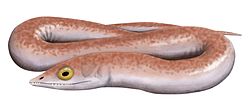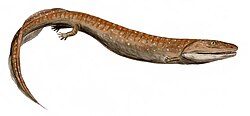| Eotetrapodiformes | |
|---|---|
 | |
| Skull of the tristichopterid Platycephalichthys in CosmoCaixa Barcelona | |
| Scientific classification | |
| Kingdom: | Animalia |
| Phylum: | Chordata |
| Clade: | Tetrapodomorpha |
| Clade: | Eotetrapodiformes Coates & Friedman, 2010 |
| Subgroups | |
| |
Eotetrapodiformes is an unranked clade of tetrapodomorphs including the four-limbed vertebrates ("tetrapods" in the traditional sense) and their closest finned relatives, two groups of stem tetrapods called tristichopterids and elpistostegalids.





